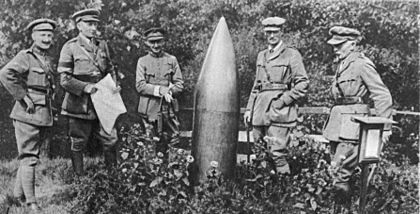Unexploded ordnance facts for kids

Unexploded ordnance (UXO, sometimes abbreviated as UO), unexploded bombs (UXBs), and explosive remnants of war (ERW or ERoW) are explosive weapons (bombs, shells, grenades, land mines, naval mines, cluster munition, and other munitions) that did not explode when they were employed and still pose a risk of detonation, sometimes many decades after they were used or discarded. When unwanted munitions are found, they are sometimes destroyed in controlled explosions, but accidental detonation of even very old explosives also occurs, sometimes with fatal results.
For example, UXO from World War I continue to be a hazard, with poisonous gas filled munitions still a problem. Also, UXO does not always originate from wars; areas such as military training bases can also hold significant numbers, even after the area has been abandoned.
Seventy-eight countries are contaminated by land mines, which kill or maim 15,000–20,000 people every year. Approximately 80% of casualties are civilian, with children the most affected age group. An estimated average of 50% of deaths occurs within hours of the blast. In recent years, mines have been used increasingly as weapons of terror against local civilian populations, specifically.
In addition to the obvious danger of explosion, buried UXO can cause environmental contamination. In some heavily used military training areas, munitions-related chemicals such as explosives and perchlorate (a component of pyrotechnics and rocket fuel) can enter soil and groundwater.
Risks and problems

Unexploded ordnance, however old, may explode. Even if it does not explode, environmental pollutants are released as it degrades. Recovery, particularly of deeply-buried projectiles, is difficult and hazardous—jarring may detonate the charge. Once uncovered, explosives can often be transported safely to a site where they can be destroyed; failing that, they must be detonated in place—sometimes requiring hundreds of homes to be evacuated.
Unexploded ordnance from at least as far back as the mid-19th century still poses a hazard worldwide, both in current and former combat areas and on military firing ranges. A major problem with unexploded ordnance is that over the years the detonator and main charge deteriorate, frequently making them more sensitive to disturbance, and therefore more dangerous to handle. Construction work may disturb unsuspected unexploded bombs, which may then explode. Forest fires may be aggravated if buried ordnance explodes and heat waves, causing the water level to drop severely, may increase the danger of immersed ordnance. There are countless examples of people tampering with unexploded ordnance that is many years old, often with fatal results. For this reason it is universally recommended that unexploded ordnance should not be touched or handled by unqualified persons. Instead, the location should be reported to the local police so that bomb disposal or Explosive Ordnance Disposal (EOD) professionals can render it safe.
In international law
Protocol V of the Convention on Certain Conventional Weapons requires that when active hostilities have ended the parties must clear the areas under their control from "explosive remnants of war". Land mines are covered similarly by Protocol II.
Detection technology
Many weapons, including aerial bombs in particular, are discovered during construction work, after lying undetected for decades. Having failed to explode while resting undiscovered is no guarantee that a bomb will not explode when disturbed. Such discoveries are common in heavily bombed cities, without a serious enough threat to warrant systematic searching.
Where there is known to be much unexploded ordnance, in cases of unexploded subsoil ordnance a remote investigation is done by visual interpretation of available historical aerial photographs. Modern techniques can combine geophysical and survey methods with modern electromagnetic and magnetic detectors. This provides digital mapping of UXO contamination with the aim to better target subsequent excavations, reducing the cost of digging on every metallic contact and speeding the clearance process. Magnetometer probes can detect UXO and provide geotechnical data before drilling or piling is carried out.
In the U.S., the Strategic Environmental Research and Development Program (SERDP) and Environmental Security Technology Certification Program (ESTCP) Department of Defense programs fund research into the detection and discrimination of UXO from scrap metal. Much of the cost of UXO removal comes from removing non-explosive items that the metal detectors have identified, so improved discrimination is critical. New techniques such as shape reconstruction from magnetic data and better de-noising techniques will reduce cleanup costs and enhance recovery. The Interstate Technology & Regulatory Council published a Geophysical Classification for Munitions Response guidance document in August 2015. UXO or UXBs (as they are called in some countries – unexploded bombs) are broadly classified into buried and unburied. The disposal team carries out reconnaissance of the area and determines the location of the ordnance. If is not buried it may be dug up carefully and disposed of. But if the bomb is buried it becomes a huge task. A team is formed to find the location of the bomb using metal detectors and then the earth is dug carefully.
See also
 In Spanish: Municiones no explotadas para niños
In Spanish: Municiones no explotadas para niños
- Ammunition dump
- Delay-action bomb
- Ordnance

